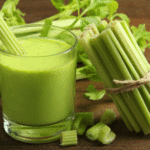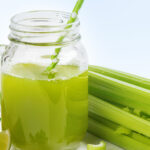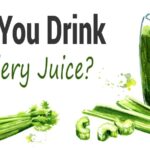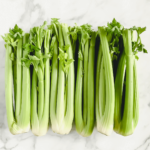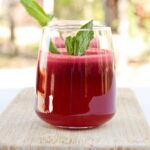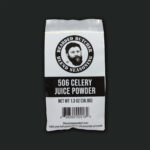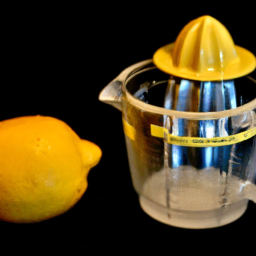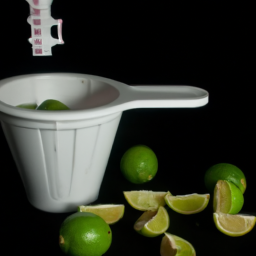Are you looking for a healthy and energizing way to start your day? Perhaps you’ve heard about the buzz surrounding celery juice and its potential health benefits. I’m here to tell you that making celery juice with a Vitamix is easier than you think!
Now, I know what you might be thinking. Celery juice? Doesn’t that sound boring and bland? But trust me, with the right technique and a few optional ingredients, celery juice can be a tasty and nutritious addition to your morning routine. Plus, using a Vitamix to make your juice ensures that all the nutrients and fiber are retained, giving you the most bang for your buck.
So, let’s get started on making some delicious celery juice!
Key Takeaways
- Making celery juice in a Vitamix is easy and retains all nutrients and fiber.
- Use fresh, organic celery stalks, add water, and strain pulp for best results.
- Experiment with optional flavorings like lemon juice, ginger, apple cider vinegar, or cucumber.
- Celery juice should be stored in an airtight glass container in the fridge for up to three days and consumed on an empty stomach for optimal absorption of nutrients.
Gather Your Ingredients
Now that you’ve decided to make celery juice in your Vitamix, it’s time to gather your ingredients and get started! The benefits of celery juice are vast and include reducing inflammation, aiding digestion, and improving skin health. It’s also a great source of vitamins and minerals like vitamin K, potassium, and folate.
There are many recipes with celery, but for our purposes, we’ll keep it simple and stick to just celery juice. To make celery juice, you’ll need a bunch of celery, preferably organic. Wash the celery thoroughly and chop it into small pieces before adding it to your Vitamix. This will make it easier for the blender to break down the celery and extract the juice.
Once you’ve washed and chopped your celery, you’re ready to move on to the next step of making delicious and healthy celery juice.
Wash and Chop Your Celery
First things first, you’ll want to grab a bunch of fresh celery from your local grocery store or farmer’s market. Before starting, it’s important to understand the benefits of washing and chopping your celery.
Washing your celery will remove any dirt or debris that may be on the stalks. This is important because consuming dirt can lead to harmful bacteria in your body. Additionally, washing celery can help remove any pesticides that may have been used during the growing process.
Once you’ve washed your celery, it’s time to chop it up. A good technique is to start by chopping off the ends and any brown spots. Then, slice the stalks into smaller pieces that will fit comfortably in your blender.
Chopping your celery into smaller pieces will make it easier to blend and create a smoother juice. By taking these steps, you’ll be able to make a delicious and nutritious celery juice that is packed with vitamins and minerals.
So, let’s move on to the next step and blend your celery and water!
Blend Your Celery and Water
Once your celery is chopped and clean, it’s time to blend it with some water for a refreshing and nutrient-packed drink. When it comes to blending techniques, using a high-powered blender like a Vitamix is ideal for achieving a smooth and consistent texture. Simply add your chopped celery and water to the blender, and blend on high for about 1-2 minutes or until the mixture is completely smooth.
Blending your celery and water not only creates a delicious and refreshing drink, but it also provides numerous health benefits. Celery juice is rich in vitamins and minerals, including vitamin K, folate, and potassium. It also contains antioxidants and anti-inflammatory compounds that can help reduce inflammation in the body. Incorporating celery juice into your daily routine can improve digestion, boost immune function, and even aid in weight loss. Once your celery and water are blended, it’s time to strain your juice to remove any pulp or fiber before enjoying your refreshing and nutrient-packed drink.
Strain Your Juice
After blending your celery and water, you’ll want to strain the juice to remove any remaining pulp or fiber. This will result in a smooth and refreshing drink. The juice consistency can be adjusted based on personal preference by using different strainer options.
If you prefer a juice with a smooth texture, a fine mesh strainer or cheesecloth can be used to remove all the pulp. On the other hand, if you prefer a juice with a bit of texture, a coarser strainer option like a nut milk bag can be used to strain the juice.
It’s important to note that straining the juice does remove some of the fiber content from the celery, which is an important component of a healthy diet. However, drinking celery juice without straining can result in a thick and fibrous drink that may not be as enjoyable to consume.
With the right strainer option, you can achieve a perfect juice consistency that is both healthy and delicious. Transitioning to the next section, you can now add optional flavorings to your celery juice to enhance the taste.
Optional Step: Add Flavorings
To enhance the taste of your celery juice, you can optionally add flavorings such as lemon juice, ginger, or apple cider vinegar. Not only do these flavoring variations add a kick to your juice, but they also offer unique health benefits.
Here are four flavoring options to consider:
-
Lemon juice: Adding a squeeze of fresh lemon juice to your celery juice can help balance out the bitter taste and add a refreshing citrus flavor. Lemons are also high in vitamin C, which can support your immune system.
-
Ginger: Adding a small piece of fresh ginger can add a spicy kick to your celery juice and help improve digestion. Ginger has been shown to have anti-inflammatory properties and may even help reduce nausea.
-
Apple cider vinegar: A splash of apple cider vinegar can add a tangy flavor to your celery juice. Some people believe that apple cider vinegar can help regulate blood sugar levels and aid in weight loss.
-
Cucumber: Adding a few slices of cucumber can add a refreshing taste to your celery juice and help hydrate your body. Cucumbers are also low in calories and high in antioxidants.
Now that you’ve added your desired flavorings to your celery juice, it’s time to serve and enjoy your delicious and healthy creation!
Serve and Enjoy
Now that I’ve made my celery juice, it’s important to store it properly so it stays fresh and retains all of its nutrients.
I typically transfer the juice to an airtight container and refrigerate it immediately.
It’s also important to drink the juice on an empty stomach, as this allows for optimal absorption of the nutrients.
Store Your Juice Properly
Don’t fret, your celery juice can be stored in an airtight container in the fridge for up to three days, but make sure to shake it up before drinking. Here are some tips to help you store your celery juice properly and preserve its freshness:
-
Use a glass container: Plastic containers can contain harmful chemicals that can seep into the juice. Using a glass container will help maintain the purity of the juice.
-
Fill it to the top: When storing celery juice, it’s important to fill the container to the top to minimize air contact. This will prevent oxidation and help keep the juice fresh.
-
Keep it cold: Celery juice should always be kept in the fridge to slow down the growth of bacteria and prevent spoilage. Make sure your fridge is set to the right temperature, which is below 40°F.
-
Don’t store it for too long: While celery juice can be stored for up to three days, it’s best to consume it as soon as possible to get the most nutrients out of it. The longer it sits in the fridge, the more the nutrients will break down.
Now that you know how to store your celery juice properly, it’s time to learn about the best way to drink it – on an empty stomach.
Drink Your Juice on an Empty Stomach
Ensure optimal nutrient absorption by consuming your freshly pressed celery juice on an empty stomach. When you drink celery juice first thing in the morning, your digestive system is at its most sensitive and receptive state.
If you consume other foods or drinks prior to celery juice, it may interfere with the body’s ability to fully absorb all the beneficial enzymes and vitamins. Drinking celery juice on an empty stomach maximizes its benefits, allowing your body to fully absorb its healing properties.
Consuming celery juice on an empty stomach can also provide the benefits of fasting. Fasting allows the digestive system to rest and reset, leading to improved digestive health. Drinking celery juice first thing in the morning can provide a similar effect, as it allows the body to focus on healing and repairing itself.
By consuming celery juice on an empty stomach, you are providing your body with a powerful tool to improve your digestive health and overall well-being. Now, let’s take a deeper dive into the specific benefits of celery juice.
Benefits of Celery Juice
You’ll be amazed at the various benefits that celery juice provides for your body. Drinking celery juice daily can help detoxify your body, as it contains antioxidants that help fight against harmful toxins.
The juice is also rich in nutrients such as vitamin K, vitamin C, and potassium, which can help improve your overall health. Moreover, celery juice has anti-inflammatory properties that can help reduce inflammation in the body. This can be particularly beneficial for those who suffer from conditions such as arthritis or asthma.
Additionally, the juice can help lower your blood pressure, reduce cholesterol levels, and improve digestion. With all these health benefits, it’s no wonder that celery juice has become a popular drink among health enthusiasts.
So, why use a Vitamix to make celery juice? Let’s find out in the next section.
Why Use a Vitamix to Make Celery Juice?
As I mentioned earlier, celery juice has a multitude of benefits for our health. But did you know that using a Vitamix to make your celery juice can enhance these benefits even further?
One of the main benefits of using a Vitamix is that it allows you to extract the maximum amount of nutrients from the celery. The powerful blades of the Vitamix break down the celery into a fine pulp, which is then easily absorbed by our bodies. This means that we get all the nutrients that celery has to offer, such as vitamins A, C, and K, potassium, and antioxidants, in a concentrated and easily digestible form.
Another benefit of using a Vitamix is that it saves time and effort. Unlike a juicer, which requires you to chop the celery into small pieces and then feed them through the machine, a Vitamix can handle whole celery stalks with ease. Plus, it’s much easier to clean and maintain a Vitamix than a juicer. Simply rinse it with water and then blend a drop of dish soap with water to clean the blades. To avoid any residue or odors, it’s important to clean your Vitamix thoroughly after each use.
Now that we know the benefits of using a Vitamix for celery juice, let’s move on to some tips for making the best celery juice.
Tips for Making the Best Celery Juice
Hey there, if you want to whip up a killer batch of this green elixir, try blending your stalks with a splash of lemon juice for an extra zing! Celery juice has become a popular trend in the health community for its numerous health benefits. And making it in a Vitamix is one of the easiest and most effective ways to get all the nutrients from this vegetable.
Here are some tips for making the best celery juice in your Vitamix:
-
Use fresh celery stalks: Ensure that the celery stalks you use are fresh and crisp. Avoid using wilted or dry stalks as they will not yield the same amount of juice.
-
Add some water: Add a small amount of water to help the blades move more efficiently and extract more juice from the celery.
-
Strain the pulp: Strain the juice through a nut milk bag or cheesecloth to remove the pulp and get a smoother texture.
-
Alternative methods and Celery juice hacks: Experiment with different ingredients such as cucumber, ginger, or apple to add more flavor and nutrients to your celery juice. You can also freeze the celery juice in an ice cube tray and add it to your smoothies or drinks for an extra boost of nutrients.
By following these tips, you can make the best celery juice in your Vitamix and enjoy all its health benefits. So, start blending and enjoy your delicious and nutritious celery juice!
Frequently Asked Questions
How long can celery juice stay fresh after it is made?
Celery juice should be consumed immediately after making for maximum benefits. If you must store it, do so in an airtight container and consume within 24 hours. Refrigeration can help preserve freshness.
Can other vegetables or fruits be added to the celery juice?
Adding cucumber to celery juice can enhance its hydration properties and provide additional antioxidants. Balancing sweetness with carrots can be achieved by using less fruit or adding lemon juice. These tips can enhance the nutritional value of celery juice.
Is it necessary to peel the celery before blending it?
The peeling debate surrounding celery is ongoing, but research suggests the skin contains more nutrients. I don’t peel my celery before blending it in my Vitamix to ensure I’m getting the most nutrients possible.
Can the leftover pulp be used in other recipes?
I hate food waste, so I always find ways to use leftover pulp from juicing. The fiber-rich pulp can be added to smoothies, soups or baked goods. Alternatively, it can be added to compost to nourish plants.
How often should celery juice be consumed to see the benefits?
To maximize health benefits and minimize potential risks, optimal timing and frequency of celery juice consumption is key. Drinking 16 ounces on an empty stomach daily is recommended, but listen to your body and adjust accordingly.
Conclusion
Well, there you have it, folks – an easy and delicious recipe for making celery juice in a Vitamix. I hope you found this guide helpful and informative, and that you enjoy your fresh and healthy juice!
As I sip on my own glass of celery juice, I can’t help but notice the beautiful coincidence around me. The sun’s shining brightly through my window, casting a warm glow on my face. I can hear the birds singing outside, and the gentle rustling of leaves in the wind.
It’s moments like these that remind me of the amazing power of nature and the incredible benefits it can offer us – just like the healing properties of celery juice. So, take a moment to appreciate the world around you, and savor every sip of your delicious celery juice.
Cheers to good health and happiness!
Ilana has been a vegan for over 10 years. She originally made the switch for health reasons, but soon found herself becoming more and more passionate about the ethical and environmental implications of a vegan lifestyle. Ilana is the author of The Graceful Kitchen, a blog all about veganism. She loves to cook up delicious and nutritious vegan meals, and share her recipes with others who are interested in leading a cruelty-free life. Ilana is also a strong advocate for using whole foods as the foundation of a healthy diet, and believes that going vegan is one of the best ways to achieve this.



